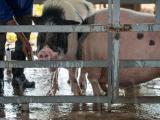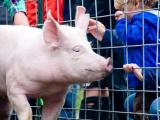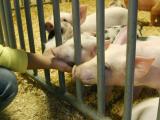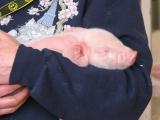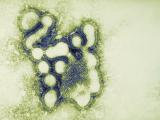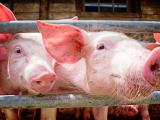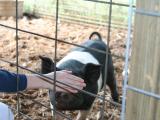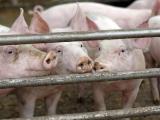Aug 31, 2012 (CIDRAP News) – Federal health officials today reported the first death from the summer outbreak of a new H3N2 flu virus, in an older adult from Ohio who had multiple underlying conditions and had direct exposure to pigs at a fair.
The US Centers for Disease Control and Prevention (CDC) also reported 12 more infections with the virus, a swine H3N2 flu variant (H3N2v) that has picked up the matrix gene from the 2009 H1N1 virus. The new cases push the national total to 290, according to the latest CDC and state case counts.
The number of states reporting cases remained at 10, with Minnesota, Ohio, Pennsylvania, and Wisconsin all reporting additional infections.
The Ohio Department of Health (ODH) said today that a 61-year-old woman from Madison County died earlier this week after becoming ill with H3N2v. It said she had other medical conditions, but the influenza infection may have contributed to her death.
The ODH added that she had direct contact with pigs at the Ross County fair before she got sick. So far the state has reported 102 H3N2v cases.
Lyn Finelli, DrPH, chief of the surveillance and outbreak response team in the CDC's influenza division, said in a statement that the CDC is saddened to hear about the death and, as for seasonal flu, continues to be concerned about people who have conditions that raise the risk of complications from the disease. The CDC has urged people in those risk groups, such as young children, those with underlying medical conditions, and older people, to avoid swine barns at fairs this summer.
"These people should absolutely not have contact with pigs or visit pig arenas at fairs this summer," she said.
She urged clinicians to ask all patients with flulike symptoms about pig exposure and to administer antiviral medication to those who have risk factors for flu complications without waiting for test results and whether or not they were exposed to pigs. "Like with seasonal flu, prompt antiviral treatment in a high risk person can mean the difference between having a milder illness versus a very serious illness that could result in a hospital stay or even death," Finelli said in the statement.
Fifteen patients so far have been hospitalized for H3N2v infections, two more than the previous week, according to CDC totals.
In its update last week, the CDC reported three instances of limited human-to-human spread, and it said today that though such spread is probably continuing sporadically, so far no sustained community transmission has been detected.
Ninety percent of the H3N2v cases have been reported in people who are exhibiting or helping to exhibit pigs at fairs this season after close and prolonged contact with pigs, the CDC said. Minnesota's two cases have links to a live animal market, and Hawaii officials have said a preliminary investigation of its case revealed that the adult patient had worked closely with pigs.
The Wisconsin Department of Health Services (WDHS) said yesterday that all of its cases occurred in people who were exposed to or were in proximity to pigs at either the Wisconsin State Fair or at fairs in Kenosha, Dodge, and Manitowoc counties.
Henry Anderson, MD, Wisconsin's state health officer, said in the statement, "Because H3N2v infections have been associated with four Wisconsin fairs already, we are recommending that older adults, pregnant women, young children, and people with weakened immune systems or chronic medical conditions should avoid entering swine barns at fairs this season." He added that the fair season in Wisconsin lasts through the middle of September.
Some southern states have fair dates that extend later into fall. For example, Texas's state fair runs from Sep 28 through Oct 21, and North Carolina's is scheduled for Oct 11 through Oct 21.
The CDC yesterday, in collaboration with 4-H National Headquarters, issued a fact sheet and recommendations for people exhibiting swine at fairs this season. It urged exhibitors and their family members who have risk factors to avoid swine barns at the fair this year, which could mean not showing pigs this year. It also urged exhibitors to watch their pigs for illness symptoms, wear protective gear when handling sick pigs, and minimize contact and unnecessary close contact with pigs in pig barns and arenas.
The CDC has said that it is watching the virus and its transmission closely, especially because the matrix gene in H3N2v might allow the virus to spread more easily among people. It has urged schools to remain vigilant for flulike illnesses in students.
The CDC reflected the new H3N2v cases in its regular weekly flu update today, which showed that a small summer spike due primarily to the infections continues to decline. Other flu markers remained well below baselines.
Also, the World Health Organization (WHO) reflected the US H3N2v activity in its global influenza update today. It said flu activity in temperate Southern Hemisphere countries continues to decline and that flu in South American countries such as Argentina, Chile, and Paraguay appears to have peaked and is declining. One area seeing an increase over the past 3 reporting weeks is South Africa, with seasonal H3N2 and influenza B most frequently detected.
A July rise in flu activity reported from parts of Asia such as southern China, Vietnam, Cambodia, and Laos has tapered off, according to the WHO.
Resistance to neuraminidase inhibitor antiviral drugs in circulating flu strains continues to be very uncommon, the WHO said. Of 762 samples tested by Australia's WHO collaborating center, only one sample showed resistance to osteltamivir (Tamiflu), and it was a 2009 H1N1 isolate that contained the H275Y mutation known to confer resistance to the drug.
See also:
Aug 31 CDC statement
Aug 31 ODH press release
Aug 31 CDC influenza update
Aug 31 CDC H3N2v case count
Aug 30 WDHS statement
Aug 30 CDC fact sheet for swine exhibitors
Aug 31 WHO global flu update
